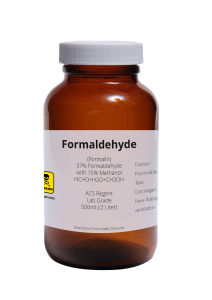1 Introduction
Formaldehyde is a volatile organic compound that we encounter frequently in our daily lives, although we may not always be aware of it. From the disinfection and sterilization of medical equipment to the preservation of tissues in pathology laboratories and the manufacture of a wide range of products, formaldehyde is a chemical that is key to many sectors. But what exactly is formaldehyde? Where does it come from and how is it used? And what are the effects on our health and the environment? In this article, we dive deep into the world of formaldehyde and explore these and other questions.

2. What is formaldehyde?
Als Chemikalie findet Formaldehyd Verwendung in vielen Prozessen und Produkten. Dabei ist eine farblose, gasförmige Verbindung, die bei Raumtemperatur einen scharfen, stechenden Geruch abgibt. Auf molekularer Ebene ist Formaldehyd die einfachste aller Aldehydverbindungen und besteht aus einem einzigen Kohlenstoffatom, das an zwei Wasserstoffatome und eine Sauerstoffgruppe gebunden ist. Dieses Molekül ist sehr reaktiv und neigt dazu, Polymerketten zu bilden, wenn es in hoher Konzentration vorliegt, ein Phänomen, das in vielen seiner Anwendungen genutzt wird. Interessanterweise stammt der Name “Formaldehyd” von der lateinischen “Formica” für Ameise ab, da es durch Oxidation aus Ameisensäure gewonnen werden kann. [1]
3. History and Discovery of Formaldehyde
Formaldehyde was discovered by the Russian chemist Alexander Mikhailovich Butlerov in the mid-19th century. Butlerow was the first to correctly identify the structure of formaldehyde and characterize its chemical properties. Since this discovery, formaldehyde has found its way into a wide variety of applications and has become one of the most commonly produced chemicals in the world. 2
4. Main Uses of Formaldehyde
-
preservation: One of the most well-known uses of formalin, an aqueous solution of formaldehyde, is as a preservative in laboratories and in embalming. Formalin helps fix biological tissue and prevent decay, making it an indispensable tool in medical research and pathology.
-
Production: Formaldehyde is a key building block in the manufacture of resins, plastics and textiles. It is used to produce phenolic, urea and melamine resins used in a variety of products such as laminates, adhesives, moldings and insulation materials.
-
Disinfection: Formaldehyde is an effective disinfectant and sterilant used in various fields, especially in medical facilities. It is often used in gas form to sterilize medical equipment and prevent the spread of infection.
5. Health Effects and Risks
Despite its usefulness, formaldehyde is not without risks. It is known to cause irritation on contact with skin or eyes and can cause respiratory problems if inhaled. With prolonged or high exposure, formaldehyde has also been linked to more serious health problems, including certain types of cancer. For this reason, it is important to take proper safety precautions when handling formaldehyde or products containing it. The problem is that even years after the exhale production of products can. Formaldehyde has been classified as a carcinogen since 2013 and since then its emission and levels in materials and food have been heavily regulated.
6. Environmental Impact of Formaldehyde
Formaldehyde also has an impact on the environment. It is known to contribute to the formation of ground-level ozone and particulate matter, both of which can cause health problems. It is also toxic to some aquatic life forms and can affect aquatic ecosystems if released into the environment in large quantities.
7. Current research and future trends
With growing concerns about the health and environmental impacts of formaldehyde, there is an intensive research effort to find safer alternatives. There are also technologies under development to reduce emissions of formaldehyde in industrial processes.
8. Conclusion
Formaldehyde, despite its multiple uses, doesn't come without its controversies. A balanced understanding of its benefits and risks is essential for its safe and effective use. It is clear that more research and innovation is needed to make the use of this important chemical more sustainable and safe.


